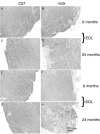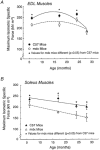Force and power output of fast and slow skeletal muscles from mdx mice 6-28 months old
- PMID: 11533147
- PMCID: PMC2278782
- DOI: 10.1111/j.1469-7793.2001.00591.x
Force and power output of fast and slow skeletal muscles from mdx mice 6-28 months old
Abstract
1. Differences in the effect of age on structure-function relationships of limb muscles of mdx (dystrophin null) and control mice have not been resolved. We tested the hypotheses that, compared with limb muscles from age-matched control mice, limb muscles of 6- to 17-month-old mdx mice are larger but weaker, with lower normalised force and power, whereas those from 24- to 28-month-old mdx mice are smaller and weaker. 2. The maximum isometric tetanic force (P(o)) and power output of limb muscles from 6-, 17-, 24- and 28-month-old mdx and control mice were measured in vitro at 25 degrees C and normalised with respect to cross-sectional area and muscle mass, respectively. 3. Body mass at 6 and 28 months was not significantly different in mdx and control mice, but that of control mice increased 16 % by 17 months and then declined 32 % by 28 months. The body masses of mdx mice declined linearly with age with a decrease of 25 % by 28 months. From 6 to 28 months of age, the range in the decline in the masses of EDL and soleus muscles of mdx and control mice was from 16 to 28 %. The muscle masses of mdx mice ranged from 9 % to 42 % greater than those of control mice at each of the four ages and, even at 28 months, the masses of EDL and soleus muscles of mdx mice were 17 % and 22 % greater than control values. 4. For mdx mice of all ages, muscle hypertrophy was highly effective in the maintenance of control values for absolute force for both EDL and soleus muscles and for absolute power of soleus muscles. Throughout their lifespan, muscles of mdx mice displayed significant weakness with values for specific P(o) and normalised power approximately 20 % lower than values for control mice at each age. For muscles of both strains, normalised force and power decreased approximately 28 % with age, and consequently weakness was more severe in muscles of old mdx than in those of old control mice.
Figures







References
-
- Anderson JE, Bressler BH, Ovalle WK. Functional regeneration in the hindlimb skeletal muscle of the mdx mouse. Journal of Muscle Research and Cell Motility. 1988;9:499–515. - PubMed
-
- Anderson JE, McIntosh LM, Moor AN, Yablonka-Reuveni Z. Levels of MyoD protein expression following injury of mdx and normal limb muscle are modified by thyroid hormone. Journal of Histochemistry and Cytochemistry. 1998;46:59–67. - PubMed
-
- Beilharz M, Lareu R, Garrett KL, Grounds MD, Fletcher S. Quantitation of muscle precursor cell activity in skeletal muscle by Northern analysis of MyoD and myogenin probes: application to dystrophic (mdx) mouse muscles. Molecular and Cellular Neuroscience. 1992;3:326–333. - PubMed
-
- Brooks SV. Rapid recovery following contraction-induced injury to in situ skeletal muscles in mdx mice. Journal of Muscle Research and Cell Motility. 1998;19:179–187. - PubMed
Publication types
MeSH terms
Substances
Grants and funding
LinkOut - more resources
Full Text Sources
Other Literature Sources
Molecular Biology Databases

